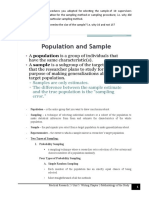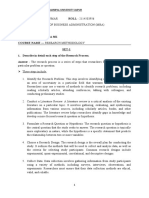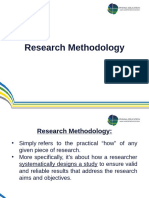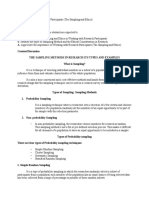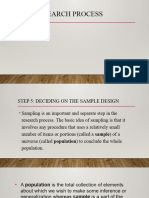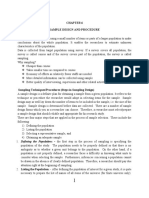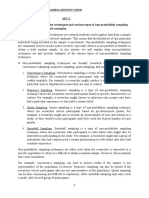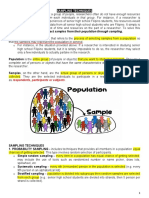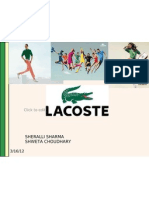PR1-Asyn - Act - October 242024
PR1-Asyn - Act - October 242024
Uploaded by
aoife7537Copyright:
Available Formats
PR1-Asyn - Act - October 242024
PR1-Asyn - Act - October 242024
Uploaded by
aoife7537Original Title
Copyright
Available Formats
Share this document
Did you find this document useful?
Is this content inappropriate?
Copyright:
Available Formats
PR1-Asyn - Act - October 242024
PR1-Asyn - Act - October 242024
Uploaded by
aoife7537Copyright:
Available Formats
Practical Research
1
SY 2024-2025
ACTIVITY SHEET
SAMPLING
1: Exploring Sampling Concepts: Answer the following Questions:
• Define population and sample.
• Explain why sampling is used instead of studying the entire population.
• Give an example of when you might use sampling in your everyday life
2: Read the information sheet about sampling (attached below)
3: Create your sampling plan on your research
• Identify the population of interest
• Specify your sampling frame
• Choose a sampling method (Snowball, Opportunistic, Convenience, or another method).
• Determine sample size (e.g., 15 students for in-depth interviews).
• Implement the plan: Write down how you will select and approach your respondents.
4: What I Have Learned: Answer the following questions.
• Why is sampling crucial in research?
• What challenges might occur if sampling is done incorrectly?
• How will you apply these sampling techniques to your own research?
Prepared by:
MA. ROSARIO W. CARSON
Master Teacher II
BRENDA M. CASIPIT
Master Teacher I
Practical Research
1
SY 2024-2025
INFORMATION SHEET SAMPLING
Population - the complete group of people, animals or objects that have the same characteristics
that the research needs Sample - a group of individuals that represent the population. The process
of choosing a sample is called sampling.
Steps in Sampling:
1. Identify the Population of Interest: Define the population relevant to your research.
2. Specify a Sampling Frame: Narrow down the population to a specific group.
3. Specify a Sampling Method: Choose a method that suits your research.
1. Purposive Sampling. This is the most common sampling procedure, wherein
participants are selected according to pre-selected criteria based on the particular research
question. To perform this sampling, a researcher begins with specific perspectives in mind
that he or she wishes to examine and then seeks out research participants who cover that
full range of perspectives.
2. Quota Sampling. In this sampling procedure, participant quotas are preset prior to
sampling. To perform this sampling, the researcher gathers data from only those participants
who meet certain characteristics that may include things such as age, place of residence,
gender, class, profession, marital status, etc.
3. Snowball Sampling. This sampling procedure is also called chain referral sampling.
To perform this sampling, the researcher recruits study participants by asking prior
participants to refer others who may be able to potentially contribute or participate in the
study. Thus, the researcher’s sample builds and becomes larger as the study continues,
much as a snowball builds and becomes larger as it rolls through the snow. This method
often helps researchers find and recruit participants that may otherwise be hard to reach.
4. Convenience Sampling. This sampling procedure is also called haphazard sampling
and is most useful in exploratory research. To perform this sampling, a researcher simply
collects data from those people or other relevant elements to which he or she has most
convenient access.
4. Determine Sample Size: Decide the number of respondents.
5. Implement the Plan: Select and interview participants, record data carefully.
You can also watch the video for your reference:
• (http://bit.ly/21k518p),
• https://www.youtube.com/watch?v=WDLzFeco8Q&ab_channel=OregonClinical
%26TranslationalResearchInstitute,
• https://www.youtube.com/watch?v=X_ufLyJbQjU&ab_channel=RESEARCHONWHEELS
You might also like
- 6.0 Research Design Sample and Sampling ProcedureDocument27 pages6.0 Research Design Sample and Sampling Procedureaoife7537No ratings yet
- PDF 2 PR1 4th (Describing Sampling Procedure)Document36 pagesPDF 2 PR1 4th (Describing Sampling Procedure)Cherryl MarigocioNo ratings yet
- PR2 Module 5 Part 2Document10 pagesPR2 Module 5 Part 2Kc RondaNo ratings yet
- App 005 Day 18 20Document42 pagesApp 005 Day 18 20Arache' EstradaNo ratings yet
- Ridl Q4 Week 1 PPTDocument57 pagesRidl Q4 Week 1 PPTnalaunankaiNo ratings yet
- Chapter IIIDocument19 pagesChapter IIIAleia ConstanteNo ratings yet
- Research MethodologyDocument10 pagesResearch MethodologyKirmadaNo ratings yet
- Research Methodology 1Document9 pagesResearch Methodology 1KirmadaNo ratings yet
- APP-005-MODULES-10-11Document38 pagesAPP-005-MODULES-10-11Julie ann MarraNo ratings yet
- Q4.L2 Sampling MethodDocument29 pagesQ4.L2 Sampling MethodChessie Nicole ArcalaNo ratings yet
- Working With Research Participants Sampling and EthicsDocument45 pagesWorking With Research Participants Sampling and EthicsJonnel GadinganNo ratings yet
- Class CH 5Document22 pagesClass CH 5wabdushukurNo ratings yet
- PR 1 4TH QTR ReviewerDocument8 pagesPR 1 4TH QTR ReviewerVinz AlilingNo ratings yet
- BRM-1 NotesDocument36 pagesBRM-1 Notessubham not a nameNo ratings yet
- Qualitative ResearchDocument34 pagesQualitative ResearchUwawU100% (1)
- Lecture PlanDocument10 pagesLecture PlanJonnel GadinganNo ratings yet
- UntitledDocument16 pagesUntitledPauleen Vivien FabiaNo ratings yet
- Writing MethodologyDocument28 pagesWriting Methodologyrixieee16No ratings yet
- Ethics and Methodology Deck 4Document58 pagesEthics and Methodology Deck 4masillamakon3No ratings yet
- Research Process OverviewDocument35 pagesResearch Process OverviewBen PhiriNo ratings yet
- ResearchDocument4 pagesResearchKriza EstocadoNo ratings yet
- IV - Understanding Ways To Collect DataDocument6 pagesIV - Understanding Ways To Collect DataJesseca Jean Aguilar Sepillo100% (6)
- Chapter 1-Obtaining DataDocument29 pagesChapter 1-Obtaining DataHanna Joy LasiNo ratings yet
- MethodsDocument36 pagesMethodsJimin parkNo ratings yet
- Marilou Budhi (The Research Process)Document14 pagesMarilou Budhi (The Research Process)Mj CabangananNo ratings yet
- Chapter 6 SamplingDocument5 pagesChapter 6 SamplingAsaminow GirmaNo ratings yet
- RM, MSCDocument10 pagesRM, MSCnarayanipanchal921No ratings yet
- Marketing Research 1Document12 pagesMarketing Research 1KirmadaNo ratings yet
- Raws Week 1-2Document3 pagesRaws Week 1-2Kazandra Cassidy GarciaNo ratings yet
- Name: Lydia Aviodita Class: VI.A NPM: 1421110074 Chapter Report Survey ResearchDocument3 pagesName: Lydia Aviodita Class: VI.A NPM: 1421110074 Chapter Report Survey ResearchLydiaavioNo ratings yet
- (Chapter 3) Narrative ReportDocument7 pages(Chapter 3) Narrative ReportMachi KomacineNo ratings yet
- MATH 403 Module 1.0 Data Collecrion and Conducting SurveysDocument21 pagesMATH 403 Module 1.0 Data Collecrion and Conducting SurveysgirlinyellowhoodieNo ratings yet
- Week 3Document37 pagesWeek 3gowthamithra monishaNo ratings yet
- Research Methodology ppt-1Document21 pagesResearch Methodology ppt-1mal28ikasaifNo ratings yet
- assignment 5 Research MethodsDocument15 pagesassignment 5 Research MethodsDr Kamal ORGNo ratings yet
- To Gather and Collect Data From Each Individuals in That Group. For Instance, If A Researcher IsDocument5 pagesTo Gather and Collect Data From Each Individuals in That Group. For Instance, If A Researcher IsRinrei Louisse SisonNo ratings yet
- Sampling 2Document8 pagesSampling 2varshasanthanamadv15No ratings yet
- Research Methodlogy by DR M. ChinthengaDocument72 pagesResearch Methodlogy by DR M. ChinthengaTimothy Manyungwa IsraelNo ratings yet
- UAPG1004 T4 Survey Student NotesDocument50 pagesUAPG1004 T4 Survey Student NotesSZE JAZZ WANGNo ratings yet
- C 3 and C 5 RESEARCH DESIGN AND SAMPLINGDocument15 pagesC 3 and C 5 RESEARCH DESIGN AND SAMPLINGfatimacontentwriter69No ratings yet
- Research MethodoloyDocument13 pagesResearch MethodoloyNivedita SolankeNo ratings yet
- Research ProcessDocument27 pagesResearch ProcessAbhay KumarNo ratings yet
- CHP 7 - Research - Process - Part - IIIDocument27 pagesCHP 7 - Research - Process - Part - IIIsinghyashwant102No ratings yet
- Chapter 2-AskingAnswering Sociological QsDocument8 pagesChapter 2-AskingAnswering Sociological Qstala.al.achiNo ratings yet
- Module 1-Obtaining DataDocument29 pagesModule 1-Obtaining DataHanna Joy LasiNo ratings yet
- Finals - ReviewerDocument17 pagesFinals - ReviewerCharmy Rose FranciscoNo ratings yet
- CHAPTER 7 Descriptive Survey ResearchDocument8 pagesCHAPTER 7 Descriptive Survey ResearchJonnel GadinganNo ratings yet
- SCIENCE SHS APPLIED PRACTICAL RESEARCH 1 Q4 WK2 - Sampling Procedure and SampleDocument8 pagesSCIENCE SHS APPLIED PRACTICAL RESEARCH 1 Q4 WK2 - Sampling Procedure and SampleGiverylle ZeronNo ratings yet
- Conduct SurveysDocument36 pagesConduct Surveysjaysaalilano88No ratings yet
- Resaerc Design,Case Study,Participatory ,Action ...Document48 pagesResaerc Design,Case Study,Participatory ,Action ...sohanbldhanavadeNo ratings yet
- Foundation of Communication ResearchDocument7 pagesFoundation of Communication Researchmaltildadouglas59No ratings yet
- Chapter 4 Research - DesignDocument63 pagesChapter 4 Research - Designteddy demissieNo ratings yet
- Engineering Data AnalysisDocument5 pagesEngineering Data AnalysisChristopher MabborangNo ratings yet
- Unit 2.2 SamplingDocument67 pagesUnit 2.2 SamplingDhruv GulatiNo ratings yet
- Research Methods in ManagementDocument71 pagesResearch Methods in ManagementArohi ChaturvediNo ratings yet
- Chapter 4 Research_designDocument55 pagesChapter 4 Research_designkassyemariyam21No ratings yet
- Types Methods of ResearchDocument77 pagesTypes Methods of Researchharabarakabab12No ratings yet
- InquiryDocument80 pagesInquiryButterfly 0719No ratings yet
- Participatory Action Research for Evidence-driven Community DevelopmentFrom EverandParticipatory Action Research for Evidence-driven Community DevelopmentNo ratings yet
- Ad2 Britanico Gold RT Jun 2021Document1 pageAd2 Britanico Gold RT Jun 2021RONALDO JACINTO PEÑA VALERIONo ratings yet
- LacosteDocument21 pagesLacosteSunny SharmaNo ratings yet
- Kitajska PodjetjaDocument12 pagesKitajska PodjetjaTroubleshootingNo ratings yet
- Chapter 9 SolutionDocument3 pagesChapter 9 SolutionAnonymous 9PQfYfXGhVNo ratings yet
- Ik Gujral Punjab Technical University Jalandhar, KapurthalaDocument111 pagesIk Gujral Punjab Technical University Jalandhar, KapurthalaKrishna AroraNo ratings yet
- Talks With US To Start Soon, Ministry Says: Xi Urges Military To Remain Steadfast in Flood BattleDocument20 pagesTalks With US To Start Soon, Ministry Says: Xi Urges Military To Remain Steadfast in Flood BattleJackZhangNo ratings yet
- Blasphemy PDFDocument2 pagesBlasphemy PDFAnn!3No ratings yet
- Supply Chain Management-PepsiDocument25 pagesSupply Chain Management-PepsiSusrita Sen98% (48)
- Recipe SpecificationsDocument6 pagesRecipe SpecificationsRovie Valdez100% (3)
- 07 10 2023 MSW 1st and 2nd Sem Nep 2023 24Document9 pages07 10 2023 MSW 1st and 2nd Sem Nep 2023 24Pradeep Singh MaithaniNo ratings yet
- Inside The Perimeter: Six Steps To Improve Your Security MonitoringDocument43 pagesInside The Perimeter: Six Steps To Improve Your Security MonitoringjeffgrantinctNo ratings yet
- How - . - I Manage Deafness in Children and Young People.Document4 pagesHow - . - I Manage Deafness in Children and Young People.Speech & Language Therapy in PracticeNo ratings yet
- Farsi 101Document7 pagesFarsi 101king shaikhNo ratings yet
- Business of Being A WriterDocument31 pagesBusiness of Being A WriterTanmay MunjalNo ratings yet
- Online PP2Document20 pagesOnline PP2Muhammad HanifNo ratings yet
- OD329366966958715100Document2 pagesOD329366966958715100GHANASYAMNo ratings yet
- 10 School of That ThoughtsDocument59 pages10 School of That ThoughtsAftab Ejaz QureshiNo ratings yet
- WR It Petition (Ci Vil) No. 1394 OF 202 3Document2 pagesWR It Petition (Ci Vil) No. 1394 OF 202 322010126029No ratings yet
- Intro. to Formal LanguagesDocument35 pagesIntro. to Formal LanguagesElias ZerabrukNo ratings yet
- Daa MCQ SetDocument20 pagesDaa MCQ SetVamsi KrishnaNo ratings yet
- PhilHealth or PhilWealthDocument2 pagesPhilHealth or PhilWealthFebbie ManalangNo ratings yet
- Die_with_Zero_31052024_052149_PMDocument3 pagesDie_with_Zero_31052024_052149_PMyayicat943No ratings yet
- G.R. No. 176020 Heirs of Julao v. de JesusDocument8 pagesG.R. No. 176020 Heirs of Julao v. de JesusVernis VentilacionNo ratings yet
- 4a's Approach Lesson Plan.Document2 pages4a's Approach Lesson Plan.Ceraz AbdurahmanNo ratings yet
- Time-Delay Systems An Overview of Some Recent Advances and Open ProblemsDocument28 pagesTime-Delay Systems An Overview of Some Recent Advances and Open Problemsmaniahmad100% (1)
- Sausage 3Document4 pagesSausage 3npxuanmai221No ratings yet
- TEFL GlossaryDocument27 pagesTEFL GlossaryTabi100% (1)
- ResearchDocument6 pagesResearchMonil ChhedaNo ratings yet
- Kepler-Track-BrochureDocument25 pagesKepler-Track-Brochurepaulova.danielaNo ratings yet
- Patran 2008 r1 Installation and Operations GuideDocument148 pagesPatran 2008 r1 Installation and Operations GuideKevinNo ratings yet



